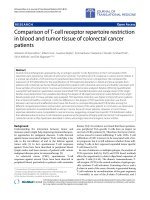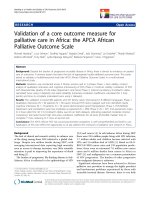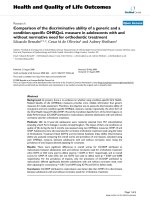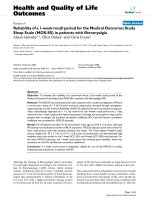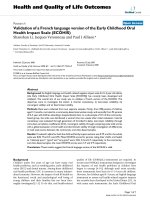báo cáo hóa học: " Comparison of the discriminative ability of a generic and a condition-specific OHRQoL measure in adolescents with and without normative need for orthodontic treatment" potx
Bạn đang xem bản rút gọn của tài liệu. Xem và tải ngay bản đầy đủ của tài liệu tại đây (252.67 KB, 6 trang )
BioMed Central
Page 1 of 6
(page number not for citation purposes)
Health and Quality of Life Outcomes
Open Access
Research
Comparison of the discriminative ability of a generic and a
condition-specific OHRQoL measure in adolescents with and
without normative need for orthodontic treatment
Eduardo Bernabé*
1,2
, Cesar M de Oliveira
2
and Aubrey Sheiham
2
Address:
1
Unidad de investigación en Salud Pública Dental, Departamento de Odontología Social, Universidad Peruana Cayetano Heredia, Lima,
Perú and
2
Department of Epidemiology and Public Health, University College London, London, UK
Email: Eduardo Bernabé* - ; Cesar M de Oliveira - ; Aubrey Sheiham -
* Corresponding author
Abstract
Background: At present, there is no evidence on whether using condition-specific Oral Health-
Related Quality of Life (OHRQoL) measures provides more reliable information than generic
measures for needs assessment. Therefore, the objective was to assess the discriminative ability of
one generic and one condition-specific OHRQoL measure, namely, respectively, the short form of
the Oral Health Impact Profile (OHIP-14) and the Condition-Specific form of the Oral Impacts on
Daily Performances (CS-OIDP) attributed to malocclusion, between adolescents with and without
normative need for orthodontic treatment.
Methods: 200 16–17-year-old adolescents were randomly selected from 957 schoolchildren
attending a Sixth Form College in London, United Kingdom. The impact of their oral conditions on
quality of life during the last 6 months was assessed using two OHRQoL measures; OHIP-14 and
OIDP. Adolescents were also examined for normative orthodontic treatment need using the Index
of Orthodontic Treatment Need (IOTN) and the Dental Aesthetic Index (DAI). Discriminative
ability was assessed comparing the overall scores and prevalence of oral impacts, calculated using
each OHRQoL measure, between adolescents with and without normative need. Using the
prevalence of oral impacts allowed adjusting for covariates.
Results: There were significant differences in overall scores for CS-OIDP attributed to
malocclusion between adolescents with and without normative need for orthodontic treatment
when IOTN or DAI were used to define need (p = 0.029 or 0.011 respectively), and in overall
scores for OHIP-14 when DAI, but not IOTN was used to define need (p = 0.029 and 0.080
respectively). For the prevalence of impacts, only the prevalence of CS-OIDP attributed to
malocclusion differed significantly between adolescents with and without normative need, even
after adjusting for covariates (p = 0.017 and 0.049 using IOTN and DAI to define need).
Conclusion: CS-OIDP attributed to malocclusion was better able than OHIP-14 to discriminate
between adolescents with and without normative needs for orthodontic treatment.
Published: 21 August 2008
Health and Quality of Life Outcomes 2008, 6:64 doi:10.1186/1477-7525-6-64
Received: 28 May 2008
Accepted: 21 August 2008
This article is available from: />© 2008 Bernabé et al; licensee BioMed Central Ltd.
This is an Open Access article distributed under the terms of the Creative Commons Attribution License ( />),
which permits unrestricted use, distribution, and reproduction in any medium, provided the original work is properly cited.
Health and Quality of Life Outcomes 2008, 6:64 />Page 2 of 6
(page number not for citation purposes)
Background
Oral Health-Related Quality of Life (OHRQoL) can be
assessed using either generic or specific measures [1,2].
Generic OHRQoL measures take into account numerous
oral conditions, some occurring simultaneously, and thus
collect information about wider effects of oral health on
daily living. The main advantage of generic measures is
that they allow comparison of various domains of quality
of life for the condition being studied, as well as across
populations and disease states [3-6]. One of the most
commonly used generic OHRQoL measures is the two
versions of Oral Health Impact Profile (OHIP); with 49 or
14 items [7,8]. On the other hand, specific OHRQoL
measures focus on a particular disease, condition, symp-
tom, function or population and thus are used when any
of the aforementioned specific attributes needs to be
assessed [1,4,5]. Condition-specific instruments are the
most commonly used specific OHRQoL measures [1],
probably because they provide more information on con-
sequences of a specific untreated oral condition or disease
and the corresponding benefits of its treatment [3,6]. The
Oral Impacts on Daily Performances (OIDP) is the only
OHRQoL measure designed to link specific oral condi-
tions, such as malocclusion, and impacts on quality of life
[9,10].
It has been claimed that condition-specific OHRQoL
measures may increase acceptability to subjects by includ-
ing only relevant dimensions [1,3,6]. In addition, their
specific focus makes them potentially more sensitive to
small, but clinically important changes in oral health
[1,4,5]. This may in turn increase responsiveness [1,3],
which is particularly important when assessing oral health
needs. Knowing whether there is an impact of the mouth
on quality of life does not necessarily provide information
on what specific dental condition was related to the
impact. Condition-specific OHRQoL measures attempt to
provide such information by attributing oral impacts to
specific oral conditions, therefore indicating which condi-
tions may require dental attention [11]. In this sense, the
condition-specific form of the OIDP index (CS-OIDP) is
an integral part of the socio-dental approach for oral
health needs assessment [12-14].
Although using condition-specific OHRQoL measures for
needs assessment seems theoretically sound, some recent
studies have also assessed oral health needs using generic
OHRQoL measures [15,16]. Empirical evidence may cast
light on whether using condition-specific OHRQoL meas-
ures provides more reliable information than generic
measures. To do that, both types of OHRQoL measures
must be evaluated first in terms of their ability to differen-
tiate between groups differing in health statuses. Such an
evaluation is part of construct validity assessment [4,17-
19]. There is no evidence on whether generic or condition-
specific OHRQoL measures are more appropriate for
assessing dental needs. Therefore, the objective of this
study was to assess the discriminative ability of one
generic and one condition-specific OHRQoL measure,
namely, respectively, the short form of the Oral Health
Impact Profile (OHIP-14) and the Condition-Specific
form of the Oral Impacts on Daily Performances (CS-
OIDP) attributed to malocclusion, between adolescents
with and without normative need for orthodontic treat-
ment.
Methods
Population and setting
Two hundred 16–17-year-old adolescents were randomly
selected from a list containing the names of all the 957
schoolchildren attending the Havering Sixth Form Col-
lege in London, United Kingdom during 2006. All the stu-
dents selected agreed to take part in the study. Sample size
was calculated to estimate a prevalence of 25% for the
condition-specific oral impacts on daily performances
attributed to malocclusion, with a maximum tolerable
error of 5% [20].
The Local Ethics Committee and the Research and Devel-
opment Directorate of the University College London
Hospitals National Health Service Trust approved this
study. Participants signed a consent letter agreeing for
their participation in the study.
Data collection
First, information about demographic characteristics (sex,
age and ethnicity), orthodontic treatment status and the
impact of oral conditions on quality of life during the last
6 months was self-reported by the participants. Informa-
tion about oral impacts was collected using OHIP-14 and
OIDP. Adolescents self-completed OHIP-14 in their class-
rooms and were later interviewed individually with OIDP
in a private room. The OHIP-14, which has been previ-
ously validated on British populations [21,22], assesses
the frequency of problems associated with the mouth,
teeth or dentures on 7 dimensions: functional limitation,
physical pain, psychological discomfort, physical disabil-
ity, psychological disability, social disability and handi-
cap. Adolescents were asked to rate each of the 14 items
on a 5-point ordinal scale coded 0 'never', 1 'hardly ever',
2 'occasionally', 3 'fairly often' and 4 'very often'. The over-
all score for OHIP-14 was obtained summing up all
responses, thus ranging between 0 and 56 points [8,23].
The OIDP index, which has also been validated on British
populations [21,24], assesses serious oral impacts on 8
daily performances namely, eating, speaking, cleaning
mouth, relaxing, smiling, studying, emotion and social
contact. If an adolescent reported an impact on any of the
8 performances, the frequency of the impact (scale from 1
to 3) and the severity of its effect on daily life (scale from
Health and Quality of Life Outcomes 2008, 6:64 />Page 3 of 6
(page number not for citation purposes)
1 to 3) were scored. If no impact was reported, then a zero
score was assigned. Thereafter, adolescents were asked to
identify from a list those oral problems that, in their opin-
ion, caused the impact. Only those Condition-Specific
Oral Impacts on Daily Performances related to 'bad posi-
tion of teeth', 'space between teeth', and 'deformity of
mouth or face', were considered in the analysis as CS-
OIDP attributed to malocclusion [14,25]. Performance
scores were estimated by multiplying the corresponding
frequency and severity scores. The overall score for the CS-
OIDP attributed to malocclusion was the sum of the 8
performance scores (ranging from 0 to 72), multiplied by
100 and divided by 72 [9,10].
Adolescents were then examined for normative orthodon-
tic treatment need using both components of the Index of
Orthodontic Treatment Need (IOTN) as well as the Den-
tal Aesthetic Index (DAI). Both indexes have gained inter-
national acceptance because they are valid, reliable and
easy to use [26-28]. For the Dental Health Component
(DHC) of IOTN, 10 traits of malocclusion were assessed:
overjet, reverse overjet, overbite, openbite, crossbite,
crowding, impeded eruption, defects of cleft lip and pal-
ate as well as any craniofacial anomaly, Class II and Class
III buccal occlusions, and hypodontia. Only the highest
scoring trait is used to assess treatment need [29]. Thereaf-
ter, adolescents self-rated their dental attractiveness on the
10-point scale of the Aesthetic Component (AC) of IOTN
[29,30]. Results from DHC and AC of IOTN were merged
into a single classification according to the current Gen-
eral Dental Services regulations of the National Health
Services in United Kingdom [31,32]. According to these
regulations, orthodontic care can only be provided for
individuals who have a DHC grade of 4 or 5, or grade 3
with an AC of 6 or above. All other cases were therefore
classified as having no need. For DAI, 10 occlusal traits
were assessed and a score was obtained using the equa-
tion: 6×(missing visible teeth) + crowding + spacing +
3×(diastema) + largest anterior maxillary irregularity +
largest anterior mandibular irregularity + 2×(anterior
maxillary overjet) + 4×(anterior mandibular overjet) +
4×(vertical anterior openbite) + 3×(anteroposterior molar
relation) + 13 [33,34]. Each adolescent was then classified
as having no need (score < 28) or need (score ≥ 28) [27].
Examinations were carried out by one of the authors
(CMO), who had been previously trained and calibrated
in the Department of Orthodontics at University of Car-
diff where the IOTN was developed. According to
weighted Kappa, inter- and intra-examiner reliability were
0.77 and 0.91 respectively.
Data analysis
Discriminative ability was examined in terms of construct
validity whereby the distributions of scores for both OHR-
QoL measures are compared between groups with differ-
ent levels of oral health [18]. Since overall scores for
OHIP-14 and CS-OIDP attributed to malocclusion were
not normally distributed (Shapiro-Wilks test, p < 0.001 in
all cases), Mann-Whitney tests were used to compare both
overall scores between adolescents with and without nor-
mative need for orthodontic treatment. To aid compari-
son and interpretation, the magnitude of differences was
also expressed as an effect size [35,36], which was calcu-
lated as the mean difference between groups divided by
the pooled standard deviation. The widely accepted
thresholds of 0.2, 0.5 and 0.8 were used to define 'small',
'moderate' and 'large' effect sizes [35].
As the aforementioned method did not allow adjusting
for covariates (sex, age, ethnicity and orthodontic treat-
ment status), the prevalence of oral impacts was also com-
pared between adolescents with and without normative
need for orthodontic treatment. For that, the prevalence
of oral impacts was calculated as the percentage of adoles-
cents reporting one or more items 'fairly often' or 'very
often' for OHIP-14 [23] and as the percentage of adoles-
cents with a score higher than zero for CS-OIDP attributed
to malocclusion [10]. Then, the prevalence of oral impacts
was compared between adolescents with and with norma-
tive need using Poisson regression with robust estimation
of variance while adjusting for covariates [37,38].
Results
This study included 134 (67.0%) females and 66 (33.0%)
males, 116 (58.0%) were aged 16 years and 84 (42.0%)
aged 17 years; 170 were Caucasian (85%) and 30 (15.0%)
were of other ethnic origins. One third (32.5%) had com-
pleted orthodontic treatment, 12.5% were currently
undergoing orthodontic treatment and the remaining
55.0% were untreated. Based on the two measures of
orthodontic need, 42 (21.0%) had a normative need for
orthodontic treatment according to IOTN whereas 25
(12.5%) had a normative need using DAI.
There were significant differences in the overall scores for
CS-OIDP attributed to malocclusion between adolescents
with and without normative need for orthodontic treat-
ment when IOTN or DAI were used to define need (p =
0.029 or 0.011 respectively), and in the overall scores for
OHIP-14 when DAI, but not IOTN was used to define
need (p = 0.029 and 0.080 respectively). Using DAI, the
mean difference in overall scores for OHIP-14 and CS-
OIDP attributed to malocclusion between adolescents
with and without normative need was 1.64 points
(CI95%: -0.84; 4.12) and 2.13% (CI95%: 0.44; 3.81)
respectively. The corresponding size effects for such mean
differences in overall scores were 0.28 (CI95%: -0.14;
0.70) and 0.53 (CI95%: 0.11; 0.95) respectively (Table 1).
Using IOTN, the mean difference in overall score for CS-
OIDP attributed to malocclusion between adolescents
Health and Quality of Life Outcomes 2008, 6:64 />Page 4 of 6
(page number not for citation purposes)
with and without normative need was 1.35% (CI95%: -
0.03; 2.72) and its corresponding size effect was 0.33
(CI95%: -0.01; 0.68).
In addition, there were significant differences in the prev-
alence of oral impacts between adolescents with and with-
out normative need for orthodontic treatment only for
CS-OIDP attributed to malocclusion (p = 0.032 and 0.049
respectively), but not for OHIP-14 (p = 0.799 and 0.211
respectively). This finding was independent of the index
used to define normative need for orthodontic treatment
(Table 2). After adjusting for covariates, adolescents with
normative need for orthodontic treatment had respec-
tively an 1.89 (CI95%: 1.12; 3.20) and 1.84-fold (CI95%:
1.00; 3.39) increase in the chance of reporting CS-OIDP
attributed to malocclusion, compared to adolescents
without normative need, when the IOTN and DAI were
used to define need.
Discussion
This study evaluated two widely used OHRQoL measures,
OHIP-14 and CS-OIDP attributed to malocclusion, in
terms of their ability to discriminate adolescents with,
from those without normative need for orthodontic treat-
ment. This was the first attempt to assess the discrimina-
tive ability of both OHRQoL measures.
When overall scores for both OHRQoL measures were
used to assess the impacts of oral conditions on everyday
life, adolescents with normative need for orthodontic
treatment always reported significantly higher OHRQoL
scores than adolescents without normative need, except
for the OHIP-14 overall score when IOTN was used to
define need. One explanation for this finding relates to
sample size. As this study was based on secondary analysis
of a prevalence study [20], no evaluation of the statistical
power for comparison purposes could be done. Though,
it must be noted that the group with normative need was
smaller when DAI than when IOTN was used to define
need (25 versus 42 adolescents), and that there were
group differences even with that smaller DAI sample. An
alternative explanation may relate to well-known differ-
ences between DAI and IOTN [26,39,40]. With IOTN only
the worst occlusal trait is recorded, which is not necessar-
Table 1: Comparison of the overall score for OHIP-14 and CS-OIDP attributed to malocclusion between adolescents with and without
normative need for orthodontic treatment.
OHRQoL
measure
Normative
need
nMeanSD p
value*
Effect
size
95% CI for
effect size
OHIP-14 No need by IOTN 158 5.13 6.00 0.080 0.13 (-0.21; 0.47)
(0–56 points) Need by IOTN 42 5.88 5.49
No need by DAI 175 5.08 5.95 0.029 0.28 (-0.14; 0.70)
Need by DAI 25 6.72 5.37
CS-OIDP No need by IOTN 158 1.13 3.63 0.029 0.33 (-0.01; 0.68)
(0–100%) Need by IOTN 42 2.48 5.25
No need by DAI 175 1.15 3.67 0.011 0.53 (0.11; 0.95)
Need by DAI 25 3.28 5.84
* Mann-Whitney test was used.
Table 2: Comparison of the prevalence of oral impacts, by OHIP-14 and CS-OIDP attributed to malocclusion, between adolescents
with and without normative need for orthodontic treatment.
Prevalence
OHRQoL
measure
Normative
need
n % PR* 95% CI
for PR
p
value
OHIP-14 No need by IOTN 21 13.3 1.00
Need by IOTN 6 14.3 1.12 (0.50; 2.49) 0.790
No need by DAI 21 12.0 1.00
Need by DAI 6 24.0 1.64 (0.76; 3.55) 0.211
CS-OIDP No need by IOTN 29 18.4 1.00
Need by IOTN 14 33.3 1.89 (1.12; 3.20) 0.017
No need by DAI 33 18.9 1.00
Need by DAI 10 40.0 1.84 (1.00; 3.39) 0.049
* Poisson regression was used to calculate prevalence ratios (PR) adjusted for sex, age, ethnicity and orthodontic treatment status.
Health and Quality of Life Outcomes 2008, 6:64 />Page 5 of 6
(page number not for citation purposes)
ily related to the participant's oral impact. In other words,
occlusal traits that affect dental appearance and have an
impact on participants' daily lives may not be captured by
IOTN. In addition, DAI has many more measures of
malocclusion affecting the anterior teeth than the IOTN.
For example, DAI includes number of missing visible
teeth, crowding in the incisal segments, spacing in the
incisal segment, and measurement of any midline
diastema that are not specifically addressed by IOTN.
However, such differences could not explain why CS-
OIDP attributed to malocclusion, but not OHIP-14 differ-
entiated adequately between adolescents with and with-
out normative need as defined by both indexes. Therefore,
this finding indicates that the expected more sensitive,
condition-specific OHRQoL measure better discriminated
between adolescents with and without normative need for
orthodontic treatment than the generic OHRQoL meas-
ure.
Furthermore, when effect sizes were used to interpret the
magnitude of mean differences in scores between adoles-
cents with and without normative need for orthodontic
treatment, better results were found for CS-OIDP attrib-
uted to malocclusion than for OHIP-14. Effect size for CS-
OIDP attributed to malocclusion was moderate whereas
effect size for OHIP-14 was nil when DAI was used to
define normative need for orthodontic treatment.
When the prevalence of oral impacts, calculated by each
OHRQoL measure, was used to assess the impacts of oral
conditions on everyday life, differences between adoles-
cents with and without normative need for orthodontic
treatment were found for CS-OIDP attributed to maloc-
clusion but not for OHIP-14. This was independent of
whether DAI or IOTN was used to define need. Generally,
adolescents with normative need for orthodontic treat-
ment had slightly more than four-fifth increase in the
probability of reporting CS-OIDP attributed to malocclu-
sions after controlling for the effects of covariates (sex,
age, ethnicity and orthodontic treatment status). The
comparison of prevalences between groups with different
oral health statuses has been reported for other OHRQoL
measures [41-43]. Unquestionably, this was an advantage
over using mean differences because there is no way to
control for covariates with non-parametric tests such as
the Mann-Whitney test.
Overall, different findings were found when comparing
the discriminative ability of OHIP-14 and CS-OIDP attrib-
uted to malocclusion between groups with and without
normative need for orthodontic treatment. These findings
differed according to the indicator used to assess the
impacts of oral conditions on participants' quality of life
(the overall score or the prevalence of oral impacts) or the
index used to define normative need for orthodontic treat-
ment (IOTN or DAI). However, based on the present find-
ings it appears that CS-OIDP attributed to malocclusion
was better able than OHIP-14 to differentiate between the
two groups of adolescents based on needs. Therefore, the
present findings confirmed our earlier assumption that
the condition-specific OHRQoL measures were better able
to discriminate between sub-groups with different levels
of oral health than their generic counterparts. This also
provides empirical support for using condition-specific
OHRQoL measures for oral health needs assessment.
Our findings agree with the few previous studies compar-
ing generic and condition-specific OHRQoL measures
[42-44]. They showed that both OHRQoL measures are
complementary, rather than alternative sources of infor-
mation. Although this holds true for situations in which
researchers are interested in assessing not only the overall
profile of oral impacts but also those impacts on quality
of life related to specific oral conditions, the present find-
ings raise the important question, does using a generic or
a condition-specific OHRQoL measure provide additional
information for oral health needs assessment when the
specific link between a specific oral condition leading to
impacts on quality of life is required to prioritise need for
professional attention? The findings from this study sug-
gest that a condition-specific OHRQoL measure should be
used in such situations. However, since these findings
were based on distinguishing between adolescents with
and without a specific type of normative need, they need
further confirmation for other oral health needs.
Conclusion
Among a population of 16–17-year-old British adoles-
cents, the CS-OIDP attributed to malocclusion was better
able than the more generic OHIP-14 to discriminate
between different levels of normative need for orthodon-
tic treatment. Findings differed according to the indicator
used to assess the impacts of oral conditions on partici-
pants' quality of life (overall score or prevalence of oral
impacts) or the index used to define normative need for
orthodontic treatment (IOTN or DAI).
Competing interests
The authors declare that they have no competing interests.
Authors' contributions
EB conceived of the study, performed statistical analysis
and drafted the first version of the manuscript. CMdO
organized and conducted the study, and has critically
revised the manuscript. AS supervised the entire study and
critically revised the manuscript. All authors read and
approved the final version of the manuscript.
Acknowledgements
Eduardo Bernabé was supported by the Programme Alßan, the European
Union Programme of High Level Scholarships for Latin America, Scholar-
ship N° E06D1000352PE.
Publish with BioMed Central and every
scientist can read your work free of charge
"BioMed Central will be the most significant development for
disseminating the results of biomedical research in our lifetime."
Sir Paul Nurse, Cancer Research UK
Your research papers will be:
available free of charge to the entire biomedical community
peer reviewed and published immediately upon acceptance
cited in PubMed and archived on PubMed Central
yours — you keep the copyright
Submit your manuscript here:
/>BioMedcentral
Health and Quality of Life Outcomes 2008, 6:64 />Page 6 of 6
(page number not for citation purposes)
References
1. Cunningham SJ, Hunt NP: Quality of life and its importance in
orthodontics. J Orthod 2001, 28(2):152-158.
2. Allen PF: Assessment of oral health related quality of life.
Health Qual Life Outcomes 2003, 1(1):40.
3. Fletcher A, Gore S, Jones D, Fitzpatrick R, Spiegelhalter D, Cox D:
Quality of life measures in health care. II: Design, analysis,
and interpretation. BMJ 1992, 305(6862):1145-1148.
4. Guyatt GH, Feeny DH, Patrick DL: Measuring health-related
quality of life. Ann Intern Med 1993, 118(8):622-629.
5. Camilleri-Brennan J, Steele RJ: Measurement of quality of life in
surgery. J R Coll Surg Edinb 1999, 44(4):252-259.
6. Kind P: Measuring quality of life in evaluating clinical interven-
tions: an overview. Ann Med 2001, 33(5):323-327.
7. Slade GD, Spencer AJ: Development and evaluation of the Oral
Health Impact Profile. Community Dent Health 1994, 11(1):3-11.
8. Slade GD: Derivation and validation of a short-form oral
health impact profile. Community Dent Oral Epidemiol 1997,
25(4):284-290.
9. Adulyanon S, Sheiham A: Oral Impact on daily performances. In
Measuring oral health and quality of life Edited by: Slade GD. Chapel Hill
, University of North Carolina; 1997:151-160.
10. Gherunpong S, Tsakos G, Sheiham A: Developing and evaluating
an oral health-related quality of life index for children; the
CHILD-OIDP. Community Dent Health 2004, 21(2):161-169.
11. Sheiham A, Tsakos G: Oral health needs assessments. In Com-
munity Oral Health Edited by: Pine C, Harris R. Mew Malden , Quintes-
sence Publishing Co. Limited; 2007:59-79.
12. Gherunpong S, Sheiham A, Tsakos G: A sociodental approach to
assessing children's oral health needs: integrating an oral
health-related quality of life (OHRQoL) measure into oral
health service planning. Bull World Health Organ 2006,
84(1):36-42.
13. Gherunpong S, Tsakos G, Sheiham A: A sociodental approach to
assessing dental needs of children: concept and models. Int J
Paediatr Dent 2006, 16(2):81-88.
14. Gherunpong S, Tsakos G, Sheiham A: A socio-dental approach to
assessing children's orthodontic needs. Eur J Orthod 2006,
28(4):393-399.
15. Astrom AN, Kida IA: Perceived dental treatment need among
older Tanzanian adults - a cross-sectional study. BMC Oral
Health 2007, 7:9.
16. Mtaya MM, Astrom AN, Brudvik PP: Malocclusion, psycho-social
impacts and treatment need: a cross-sectional study of Tan-
zanian primary school-children. BMC Oral Health 2008, 8(1):14.
17. Walters SJ, Morrell CJ, Dixon S: Measuring health-related quality
of life in patients with venous leg ulcers. Qual Life Res 1999,
8(4):327-336.
18. Streiner DL, Norman GR: Health Measurement Scales. A prac-
tical guide to their development and use. 3rd edition. New
York , Oxford University Press; 2003.
19. McTaggart-Cowan HM, Marra CA, Yang Y, Brazier JE, Kopec JA, Fit-
zgerald JM, Anis AH, Lynd LD: The validity of generic and condi-
tion-specific preference-based instruments: the ability to
discriminate asthma control status. Qual Life Res 2008.
20. Bernabé E, Sheiham A, de Oliveira CM: Impacts on daily perform-
ances attributed to malocclusions by British adolescents. J
Oral Rehab 2008.
21. Robinson PG, Gibson B, Khan FA, Birnbaum W: Validity of two
oral health-related quality of life measures. Community Dent
Oral Epidemiol 2003, 31(2):90-99.
22. Fernandes MJ, Ruta DA, Ogden GR, Pitts NB, Ogston SA: Assessing
oral health-related quality of life in general dental practice in
Scotland: validation of the OHIP-14. Community Dent Oral Epide-
miol 2006, 34(1):53-62.
23. Slade GD, Nuttall N, Sanders AE, Steele JG, Allen PF, Lahti S:
Impacts of oral disorders in the United Kingdom and Aus-
tralia. Br Dent J 2005, 198(8):489-93; discussion 483.
24. Yusuf H, Gherunpong S, Sheiham A, Tsakos G: Validation of an
English version of the Child-OIDP index, an oral health-
related quality of life measure for children.
Health Qual Life Out-
comes 2006, 4:38.
25. Bernabé E, Tsakos G, de Oliveira CM, Sheiham A: Impacts on daily
performances attributed to malocclusions using the condi-
tion-specific feature of the Oral Impacts on Daily Perform-
ances Index. Angle Orthod 2008, 78(2):241-247.
26. Jenny J, Cons NC: Comparing and contrasting two orthodontic
indices, the Index of Orthodontic Treatment need and the
Dental Aesthetic Index. Am J Orthod Dentofacial Orthop 1996,
110(4):410-416.
27. Beglin FM, Firestone AR, Vig KW, Beck FM, Kuthy RA, Wade D: A
comparison of the reliability and validity of 3 occlusal indexes
of orthodontic treatment need. Am J Orthod Dentofacial Orthop
2001, 120(3):240-246.
28. Jarvinen S: Indexes for orthodontic treatment need. Am J
Orthod Dentofacial Orthop 2001, 120(3):237-239.
29. Brook PH, Shaw WC: The development of an index of ortho-
dontic treatment priority. Eur J Orthod 1989, 11(3):309-320.
30. Shaw WC, Richmond S, O'Brien KD: The use of occlusal indices:
a European perspective. Am J Orthod Dentofacial Orthop 1995,
107(1):1-10.
31. NHS: General dental services contracts. Regulations 2005.
National Health Service; 2005.
32. de Oliveira CM: The planning, contracting and monitoring of
orthodontic services, and the use of the IOTN index: a sur-
vey of consultants in dental public health in the United King-
dom. Br Dent J 2003, 195(12):704-6; discussion 696.
33. Cons NC, Jenny J, Kohout FJ: DAI: the dental aesthetic index.
Iowa City , College of Dentistry, University of Iowa; 1986.
34. Cons NC, Jenny J, Kohout FJ, Songpaisan Y, Jotikastira D: Utility of
the dental aesthetic index in industrialized and developing
countries. J Public Health Dent 1989, 49(3):163-166.
35. Cohen J: Statistical power analysis for the behavioural sci-
ences. 2nd edition. New Jersey , Lawrence Erlbaum Associates;
1988:8-17.
36. Kazis LE, Anderson JJ, Meenan RF: Effect sizes for interpreting
changes in health status.
Med Care 1989, 27(3 Suppl):S178-89.
37. Barros AJ, Hirakata VN: Alternatives for logistic regression in
cross-sectional studies: an empirical comparison of models
that directly estimate the prevalence ratio. BMC Med Res
Methodol 2003, 3:21.
38. Petersen MR, Deddens JA: A comparison of two methods for
estimating prevalence ratios. BMC Med Res Methodol 2008, 8:9.
39. Freer E, Freer TJ: Variations in treatment need using four
screening methods. Aust Orthod J 1999, 15(4):214-218.
40. Johnson M, Harkness M, Crowther P, Herbison P: A comparison of
two methods of assessing orthodontic treatment need in the
mixed dentition: DAI and IOTN. Aust Orthod J 2000,
16(2):82-87.
41. Allen PF, McMillan AS, Walshaw D, Locker D: A comparison of the
validity of generic- and disease-specific measures in the
assessment of oral health-related quality of life. Community
Dent Oral Epidemiol 1999, 27(5):344-352.
42. Lee S, McGrath C, Samman N: Quality of life in patients with
dentofacial deformity: a comparison of measurement
approaches. Int J Oral Maxillofac Surg 2007, 36(6):488-492.
43. McMillan AS, Pow EH, Leung WK, Wong MC, Kwong DL: Oral
health-related quality of life in southern Chinese following
radiotherapy for nasopharyngeal carcinoma. J Oral Rehabil
2004, 31(6):600-608.
44. Shugars DA, Gentile MA, Ahmad N, Stavropoulos MF, Slade GD, Phil-
lips C, Conrad SM, Fleuchaus PT, White RP Jr.: Assessment of oral
health-related quality of life before and after third molar sur-
gery. J Oral Maxillofac Surg 2006, 64(12):1721-1730.



